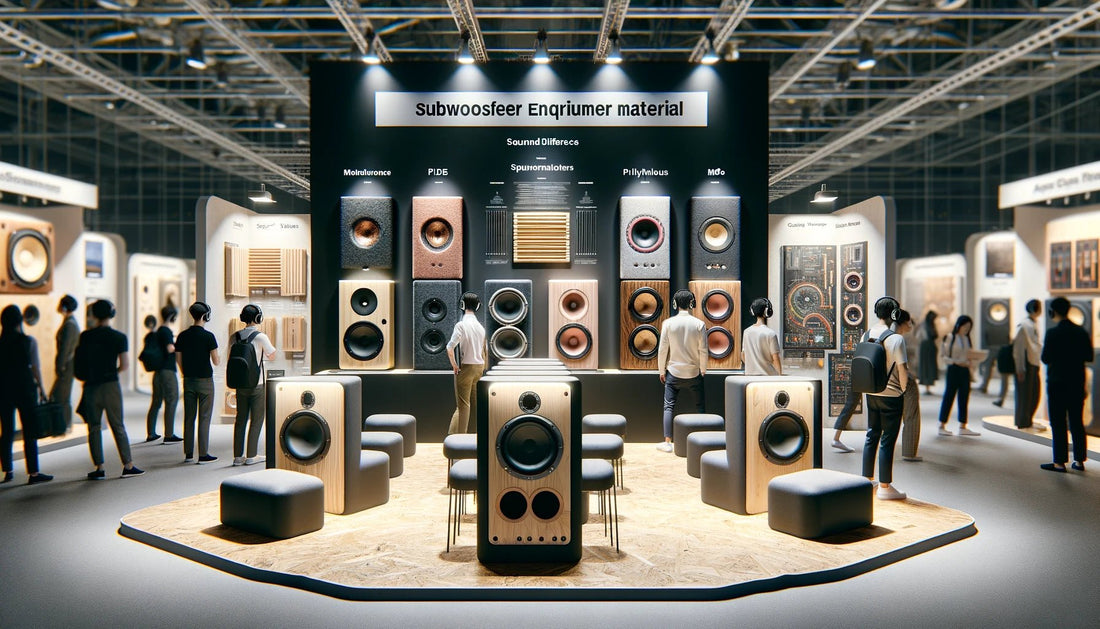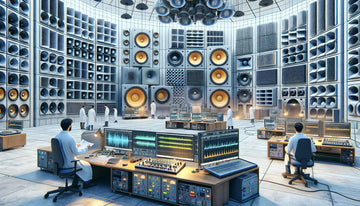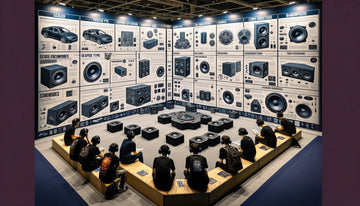
Comparing Enclosure Materials and Acoustics: A Deep Dive
Sound quality is crucial in audio systems, whether in cars, homes, or professional sound setups. A critical component that significantly impacts sound quality is the enclosure in which the speaker is housed, including the subwoofer.
The choice of enclosure material and design can significantly affect the speaker's bass response, frequency range, and overall acoustic properties. In this blog, we will explore the different types of enclosures, the materials used in their construction, and the acoustic performance and design principles that contribute to optimal sound output.
Elevate your audio experience to new heights by uncovering the diverse world of Subwoofer Enclosure Types. Find the perfect match for your subwoofer, fine-tune your bass response, and unleash the full potential of your sound system. Dive into enclosure variety for superior bass performance today!
Understanding Different Enclosure Types

When considering speaker enclosures, there are three main types to choose from: sealed, ported, and bandpass. Each type has a unique design and acoustic properties influencing the sound output. Understanding these enclosure types and their characteristics is essential for informed decision-making regarding speaker setup.
Sealed Enclosures
Sealed or acoustic suspension enclosures provide tight, accurate bass with controlled acoustic properties. The design of sealed enclosures minimizes distortion and provides cleaner sound output compared to other enclosure types. This makes sealed enclosures ideal for audiophiles who value precise sound reproduction. The sealed enclosure design ensures a transient response, meaning the speaker reacts quickly to changes in the audio signal. This transient response contributes to the clarity and accuracy of the sound produced. Understanding the acoustic properties of sealed enclosures is crucial for achieving the desired bass response and sound quality.
Another advantage of sealed enclosures is that they effectively contain sound within the enclosure, reducing interference from the ambient environment. This is particularly beneficial in car audio setups, where external noise can easily interfere with the sound output. By keeping the soundwaves contained, sealed enclosures help maintain the integrity of the audio and deliver a more immersive listening experience.
Ported Enclosures
Ported enclosures, also known as bass reflex enclosures, use a specifically designed port to enhance the bass output of the loudspeaker. The ported enclosure design works by utilizing sound waves produced at the tuning frequency to boost the bass response within the enclosure volume. This design allows for a more efficient use of the loudspeaker's power, resulting in louder and deeper bass.
The tuning frequency of the ported enclosure plays a crucial role in achieving the desired bass response. By carefully selecting the tuning frequency, the ported enclosure can be optimized to emphasize specific frequencies within the low-frequency range. This customization allows a tailored sound output to suit the listener's preferences. However, it's important to note that ported enclosures have specific amplifier power requirements, so choosing an amplifier that can effectively power the speaker in a ported enclosure setup is essential.
Bandpass Enclosures
Bandpass enclosures are designed to optimize bass response within a specific frequency range, typically between 20 and 200 Hertz. These enclosures employ a combination of sealed and ported designs, effectively filtering out unwanted frequencies and focusing on the desired range. The bandpass enclosure design allows the speaker to work with the enclosure, resulting in a more controlled and efficient sound output. This design is especially effective for handling Sub-30 Hertz behavior, as sealed box designs and single-reflex bandpasses are much better at controlling excursion at extremely low frequencies, making them less prone to low-frequency induced speaker damage.
The unique box design of bandpass enclosures plays a vital role in their sound output. By carefully tuning the enclosure, the frequencies within the desired range can be amplified, enhancing the bass response. This precision tuning contributes to the overall sound quality and allows maximum sound output within the set frequency range.
Understanding the box design and its impact on the sound output is crucial when considering a bandpass enclosure. By utilizing the differential tuning of the enclosure, the sound waves can be accurately directed to achieve the desired bass response. This design allows the speaker's full potential to be harnessed, resulting in a more immersive listening experience.
Materials Used in Enclosure Construction

When Comparing Enclosure Materials and Acoustics, the choice used in enclosure construction significantly impacts the acoustic properties and overall sound quality. Different materials have varying densities, resonance characteristics, and structural properties that can influence the sound output. The following sections explore three commonly used enclosure materials: Medium Density Fiberboard (MDF), plywood, and fiberglass.
Medium Density Fiberboard (MDF)
Medium Density Fiberboard (MDF) is famous for speaker enclosure construction due to its favorable acoustic properties and ease of use. MDF is an engineered wood product that consists of wood fibers compressed with adhesive resin. This composition produces a dense, uniform material that minimizes sound cancellation and resonance, improving sound quality.
The acoustic properties of MDF make it an excellent choice for enclosure design. Its density contributes to precise enclosure tuning, optimizing the bass response and frequency range. MDF enclosures provide consistent acoustic properties, ensuring reliable sound output across various frequencies. MDF enhances the low-frequency response, resulting in improved sound clarity. MDF's acoustic properties make it a preferred material for professional audio applications, where precise sound reproduction is essential.
Plywood
Plywood is another commonly used material in speaker enclosure construction, favored for its robustness and resonance control. Plywood is made by layering thin sheets or wood veneers and bonding them with adhesive. The arrangement of the layers creates a sturdy and durable material ideal for enclosure construction.
The acoustic properties of plywood make it an excellent choice, particularly for low frequencies. The density and structure of plywood contribute to the overall sound quality and bass response. The resonance control provided by plywood helps minimize sound distortion, resulting in more precise sound output. Additionally, plywood's acoustic properties make it well-suited for bracing, enhancing enclosure rigidity and reducing enclosure resonance.
Different types of plywood can be used for speaker enclosure construction, with hardwood plywood, such as birch plywood, being a popular choice due to its strength and durability. The selection of the plywood type depends on factors such as the desired sound output, budget, and ease of use, making it a versatile option for DIY enthusiasts and audio industry professionals.
Fiberglass
Fiberglass is a unique enclosure material that offers flexibility and customization options. It involves applying resin and fiberglass matting layers to create a rigid and lightweight enclosure. The fiberglass composite structure creates custom enclosure shapes, which can be tailored to specific acoustic requirements.
One of the main advantages of fiberglass enclosures is their excellent sound insulation properties. Fiberglass minimizes interference and provides cleaner sound output by isolating the speaker from the ambient environment. Additionally, applying fiberglass matting and resin allows for creating intricate vent and port design, maximizing bass output and optimizing the overall sound quality.
Fiberglass enclosures are also known for their strength and rigidity, contributing to the reduction of enclosure resonance. The bracing techniques used in fiberglass construction further enhance the enclosure's structural integrity, reducing vibrations and minimizing sound distortion. Moreover, the acoustic properties of fiberglass enable the enclosure volume to be optimized, ensuring the speaker operates efficiently within the intended frequency range.
Acoustic Comparison of Different Enclosure Materials

Now that we have explored the different enclosure materials let's compare their acoustic performance to understand how they impact the sound output. Each enclosure material has unique properties influencing the frequency response, bass output, and sound quality.
Acoustic Performance of MDF
MDF's acoustic performance highlights its ability to minimize sound distortion and resonance, resulting in improved sound quality. The density and consistency of MDF contribute to its acoustic properties, allowing for precise bass response and transient sound output. MDF exhibits reliable acoustic performance across varying frequencies, ensuring consistent sound quality compared to other materials.
The choice of MDF for enclosure construction directly impacts the frequency response and sound output. Due to its favorable acoustic properties, MDF enhances the low-frequency response, resulting in deeper bass and more defined sound. This makes MDF an ideal material for achieving the desired sound output in speaker systems, regardless of the genre or audio application.
Acoustic Performance of Plywood
With its robustness and resonance control, Plywood offers distinct acoustic performance characteristics. The acoustic properties of plywood contribute to sound clarity, especially in the low-frequency range. Plywood's ability to minimize sound cancellation and resonance ensures a frequency response that minimizes distortion, resulting in clean sound output.
One of the advantages of plywood enclosures is their adaptability to the ambient environment. By effectively canceling out external noise, plywood enclosures maintain the integrity of the sound produced, providing a more immersive listening experience. This adaptability makes plywood enclosures suitable for various audio setups, from home theaters to car audio systems.
Acoustic Performance of Fiberglass
Fiberglass enclosures offer unique acoustic performance characteristics due to their sound insulation properties and design flexibility. Fiberglass in enclosure construction reduces sound distortion, producing clean and accurate sound output. Fiberglass enclosures provide optimal sound quality by effectively isolating the speaker from ambient noise, particularly in environments with high ambient noise levels.
The acoustic properties of fiberglass allow for unrivaled enclosure volume optimization. Through careful enclosure design, the acoustic properties of fiberglass, such as its rigidity and resonance control, can be harnessed to achieve enhanced acoustic efficiency. This optimization ensures the speaker operates efficiently within the intended frequency range, improving sound clarity and output.
Designing Enclosures for Optimal Acoustics

Certain factors must be considered when designing speaker enclosures to achieve optimal acoustic performance. These factors include calculating enclosure volume for sound quality and selecting the right enclosure shape to suit sound preferences.
Calculating Enclosure Volume for Sound Quality
Accurate enclosure volume calculation is crucial for sound quality, especially in the bass response. The enclosure volume directly influences the tuning frequency, which is critical for achieving the desired frequency response. Calculating the enclosure volume precisely can achieve optimal transient response, resulting in improved sound quality.
One specific enclosure design where enclosure volume plays a vital role is the sealed enclosure design. The bass response can be optimized by carefully calculating the enclosure volume, ensuring accurate sound reproduction. Combined with the correct enclosure volume, the sealed enclosure design delivers a clean, tight bass output well-suited for various audio applications.
Choosing the Right Enclosure Shape for Sound Preference
The shape of the enclosure significantly influences the sound output and acoustic properties. Different enclosure shapes can have varying effects on the behavior of sound waves, impacting the frequency response and overall sound quality. When choosing the right enclosure shape, it's essential to consider sound preference and the desired sound characteristics. Here are some key points to consider:
- The enclosure design should be chosen based on the desired sound preference, whether emphasizing bass response, achieving a balanced sound, or focusing on specific frequency ranges.
- Enclosure shape affects the resonance characteristics, cancellation, and interference within the enclosure, leading to variations in the sound output.
- Different enclosure shapes may require different tuning methods to achieve the desired sound output.
- The enclosure shape influences the ambient environment adaptability, ensuring the sound output remains consistent, regardless of the listening environment.
- Understanding the impact of enclosure shape on resonance, cancellation, and soundwave behavior is crucial when selecting the enclosure design that best suits sound preference.
Principles of Enclosure Design for Better Acoustics
Certain principles must be considered when designing speaker enclosures to achieve better acoustics. These include understanding the frequency range, amplifier power requirements, and transient response of the speaker system.
Acoustic Principles to Consider
Several acoustic principles should be considered when designing speaker enclosures to optimize the sound output and ensure better acoustics. Here are some fundamental principles:
- Frequency range: Understanding the speaker's frequency range helps design an enclosure that accommodates the desired sound output, especially for low frequencies.
- Amplifier power requirements: Different enclosure types and materials have different amplifier power requirements, and considering this principle ensures the speaker operates optimally within the enclosure volume.
- Transient response: The transient response of the speaker refers to how quickly it responds to changes in the audio signal. Optimizing the transient response contributes to better sound quality and accuracy.
Measuring and Calculating Box Dimensions for Acoustic Efficiency
Measuring and calculating box dimensions is crucial for achieving acoustic efficiency in speaker enclosures. Accurate measurement ensures the enclosure is designed to the desired frequency response and bass output. Additionally, calculating box dimensions facilitates the tuning frequency required for optimal sound output. Attention to detail in the measuring and calculation process helps achieve the acoustic properties desired for sound quality.
The vent or port design is another factor to consider when designing the box dimensions. The vent is a passage for sound waves, influencing the bass response and overall sound output. Proper vent design enhances the speaker's bass response, minimizing distortion and maximizing acoustic efficiency. It is essential to consider the vent design and box dimensions to optimize the sound output of the speaker enclosure.
How to Choose Between Different Enclosure Types and Materials?
Choosing the right enclosure type and material can be a challenging task. Several factors should be considered, including sound preferences and the impact of the enclosure material on the acoustic output. Let's take a closer look at these factors.
Considering Your Sound Preferences
Sound preference is one of the critical factors to consider when choosing between different enclosure types and materials. Different enclosure types and materials produce different sound characteristics, and selecting the one that aligns with personal sound preferences can significantly enhance the listening experience.
Sealed enclosures with MDF construction might be the preferred choice for audiophiles who value precise sound reproduction. These enclosures provide tight, accurate bass with controlled acoustic properties, ensuring optimal sound quality. On the other hand, ported enclosures, emphasizing bass output, may appeal to those looking for a more powerful low-frequency response. Finally, bandpass enclosures offer the option to filter out unwanted frequencies, focusing on a specific range, which can benefit specific audio setups.
When considering the impact of enclosure materials on sound preference, it's important to remember that different materials have varying acoustic properties. This influences the frequency response, bass output, and overall sound quality. Considering sound preferences while selecting the enclosure type and material helps ensure a customized audio experience that meets individual tastes and audio system requirements.
How Does the Material of the Enclosure Impact the Acoustic Output?
The material used for the enclosure significantly impacts the acoustic output of the speaker system. Different enclosure materials have varying acoustic properties, resonance characteristics, and structural properties. Let's explore how the enclosure material can impact the acoustic output:
- The enclosure material influences the frequency response, bass output, and sound quality. Each material has unique acoustic properties, which can alter how sound waves behave within the enclosure.
- The selection of enclosure material also impacts the design and tuning of the enclosure. Different materials may require varying enclosure volumes, vent designs, and tuning frequencies to achieve optimal sound output.
- Understanding the acoustic properties of the enclosure material helps make informed decisions about the design, shape, and volume, resulting in better sound quality.
- For example, MDF is known for its density and consistency, which promotes sound clarity and precise bass response. Plywood, with its resonance control, provides cleaner sound output. Fiberglass, with its insulation properties, offers enhanced sound quality by isolating the speaker from the ambient environment.
- By considering the acoustic properties of the enclosure material and how it aligns with sound preferences, audio enthusiasts can make informed decisions when choosing the suitable enclosure materials for their speaker systems.
Conclusion
In conclusion, understanding the different types of enclosures and materials used in their construction is essential for achieving optimal acoustics. Sealed enclosures provide precise and accurate sound reproduction, while ported enclosures offer increased bass response. Bandpass enclosures combine the benefits of both. Regarding enclosure materials, medium-density fiberboard (MDF) is famous for its durability and resonance control. Plywood offers a more natural and warm sound, while fiberglass provides excellent strength and vibration resistance. Consider factors such as enclosure volume and shape to design an enclosure that meets your sound preferences. Remember, the material of the enclosure can significantly impact the acoustic output. So, choose wisely based on your desired sound quality.

















